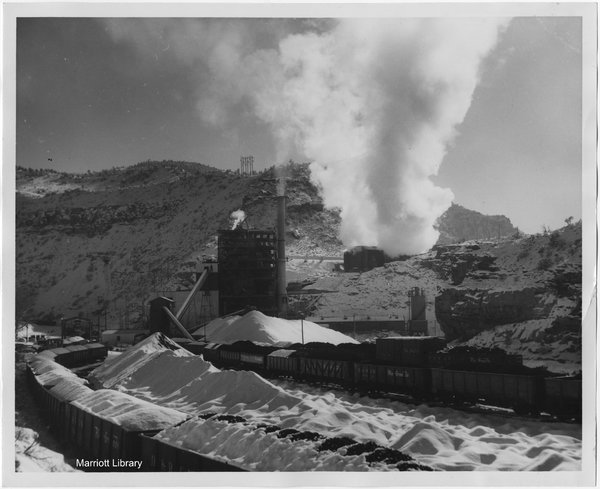Dublin Core
Title
Description
The early decades of the 1900s were marked by a growing demand for electricity and new power technologies sought to fill that need. Wind, hydro, or solar might come to mind as generators of electricity, but in the early 20th century, steam was a popular driver of reliable electrical power.
Steam power works by creating a vapor cycle in which fuel -- often burning coal -- is used to produce heat in a boiler, which converts water into steam. The steam pressure rotates a turbine that generates mechanical energy. A generator attached to the turbine converts mechanical energy into electrical energy.
As electricity became essential for homes and businesses, power companies were eager to oblige their growing customer base, particularly in regions that had yet to be electrified. Utah’s major utility company -- Utah Power & Light -- capitalized on the demand for steam power and built several plants throughout the state, beginning in the 1920s.
In 1954, UP&L built the Carbon Power Plant at the mouth of Price Canyon, adjacent to the Castle Gate Mine and the Price River. The location offered proximity to fuel and water needed to operate a steam plant. Before this, Carbon County used to send coal to northern Utah steam plants and got electricity back via transmission lines. But the new power plant had ready access to both fuel and water without needing to truck anything in. At its peak, the Carbon plant generated enough electricity to serve roughly 300,000 people in central Utah.
But steam plants require a deceptively large amount of water to operate. Millions of gallons per day are needed to create steam and cool condensers. In addition, burning coal to create steam contributes mightily to air pollution. The Carbon Power Plant was the longest continuously-operating steam plant in the UP&L system, but its location made facility upgrades difficult and costly. When stricter regulations for mercury pollution came into effect, the plant was retired in 2015. It was one of many coal-fired plants that closed around the country as demand for greener technologies increased in the 21st century.
Creator
Source
_______________
See Obed C. Haycock, “Electric Power Comes to Utah,” Utah Historical Quarterly (vol. 45, no.2), Spring 1977;John S. McCormick, “Electrical Development in Utah,” Utah History Encyclopedia; Amy Joi O’Donoghue, “End of An Era: Mercury Rule Shutters Utah’s Oldest Power Plant,” Deseret News, April 14, 2015; Brian Maffly, “Utah’s Carbon Power Plant Heads for Early Retirement,” The Salt Lake Tribune, October 21, 2013; Leia Larsen, “Utah Coal Plants Guzzle Water,” The Salt Lake Tribune, May 1, 2022; “Power Flows from New Carbon Plant,” Times Independent, September 5, 1957; “Mine-Mouth Electric Generating Plant Supplies 66,000 Kilowatts to Utah,” Times Independent, February 24, 1955; Robert Lamb, “How Steam Technology Works,”HowStuffWorks, February 27, 2008; “Utah Power and Light Company,” Company History; US Energy Information Administration, “Utah,” State Profile and Energy Estimates, April 21, 2022.

